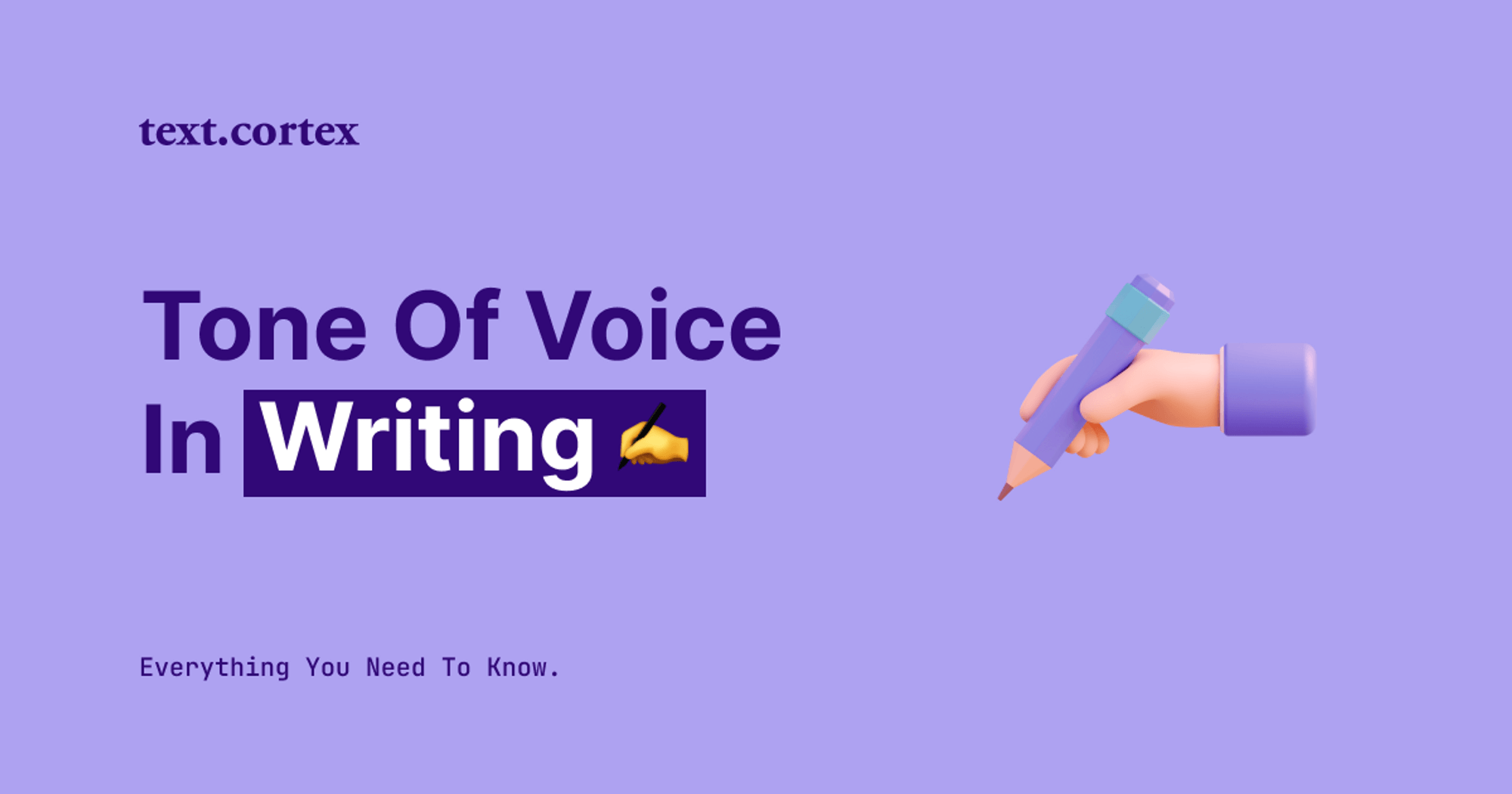Writing is a powerful way to share our thoughts and ideas with others.
Even though our words are essential, how we say them is just as important for getting our message across.
The tone of voice in our writing is designed to show how we feel or think.
Moreover, it can affect how people preserve our writing and how they respond to what we're trying to say.
So anyone who wants to be a better writer needs to master different narratives in writing to communicate their message more effectively.
This article will tell you everything you need to know about the tone of voice in writing, including what it is, why it's important, and how to use it skillfully.
Let’s start!
TL;DR
- Writing with the right tone of voice can do wonders for your credibility, the atmosphere you create, and your ability to connect with your readers.
- Learn about the various types of tone of voice and how they can be used to better communicate with your target audience.
- Explore strategies for using a suitable voice in your writing to achieve your goals and engage your readers,
- See how to leverage the latest developments in AI technology to alter the voice of your writing automatically.
What is the Tone of Voice in Writing?
The tone of voice in writing is the author's chosen method of expression, which can be anything from formal and objective to casual and subjective.
The writer's style encompasses not only their selection of words but also their use of grammar and syntax and overall approach to the subject matter.
To communicate clearly and make an impression on your audience, you must master the nuances of using the right tone for various writing tasks.
Importance of the Tone of Voice in Writing
In a nutshell, the tone of one's writing is a crucial component of effective communication.
And here are several factors that highlight the significance of voice in written communication:
✔️ Can be useful for establishing the writer's authority and credibility in the field.
✔️ Possesses the ability to guarantee that the reader receives the intended message.
✔️ Allows the writer to better relate to the readers they've been trying to reach.
✔️ May evoke the reader's reaction, making for a more interesting and memorable piece of writing.
But how can you tell the difference between different voices?
The Different Types of Tone of Voice
To tell the difference between different voices, it's important to consider several factors, including:
1. Word choice – The words we choose for a piece of writing can give a hint at the author's personality. For instance,formal writing uses more technical language, while informal writing uses more conversational language.
2. Sentence structure – The way sentences are put together can also reveal a speaker's mindset or mood. In contrast to the shorter, simpler sentences that may be used in informal writing, longer, more complex sentences are common in formal writing.
3. Use of pronouns – Pronoun choice can also provide insight into the speaker's emotional state. For instance, while third-person pronouns (he, she, they) are more common in academic and professional writing, first-person pronouns (I, me, we) are more common in informal writing.
4. Attitude – The tone and style of writing can also reveal the author's perspective. A writer who is passionate about the subject may use more exclamation points and upbeat language, while a skeptic or critic may lean more heavily on negative language.
But there are many different ways to write in a tone of voice, and each one has its own traits and effects on the reader.
Here are some of the most common kinds of writing voice:
1. Formal Tone
When writing for business or school, you should use a formal tone. It features a tone that is serious, sophisticated, and neutral.
Formal writing is usually very clear and doesn't use slang, colloquialisms, or contractions.
Formal Tone Example
One instance of how writers frequently use a formal tone is in a research paper on the effects of climate change:
"Recent studies have indicated a correlation between the increased frequency and severity of natural disasters, such as hurricanes and wildfires, and the rise in global temperatures caused by human activities."
2. Informal Tone
If you are writing for a more casual or personal audience, you should use a more casual tone.
It has a friendly, conversational, and easy-going voice.
Informal writing is often written in everyday language and may use slang and contractions.
Informal Tone Example
For instance, when writing a personal blog post about a recent trip, you can use an informal and more casual tone.
"I couldn't believe my luck when I stumbled upon a hidden gem of a restaurant in the heart of Paris - the cozy atmosphere, delicious food, and friendly staff made it the highlight of my trip!"
3. Objective Tone
When writing to give information or facts without bias or personal opinion, we use an objective tone.
It has a voice that is neutral and detached. Most of the time, the language used in objective writing is clear and straightforward.
Objective Tone Example
For example, a news article reporting on a political event is precisely an excellent example of an objective writing tone.
"The government's proposed policy to increase taxes on luxury goods has been met with criticism from opposition leaders, who argue that it will have a negative impact on the economy."
4. Subjective Tone
When we want to share our own thoughts or feelings in writing, we adopt a more subjective tone. It has an open to interpretation, biased, and emotional voice.
Expressive language, including metaphors, is common in subjective writing.
Subjective Tone Example
Examples of subjective tone of voice include personal essays, blog posts, and reviews of movies.
"I was blown away by the stunning cinematography and powerful performances in the new drama film, which left me in tears by the end."
5. Humorous Tone
When the goal of one's writing is to make the reader laugh or smile, a humorous tone is employed. It has a voice that is playful, witty, and comedic.
Humorous writing frequently makes use of irony, sarcasm, and puns in its language.
Humorous Tone Example
The following is an example of a satirical article that uses a humorous tone while discussing current events.
"Experts say that the key to solving the current political crisis is to simply gather all the politicians in a room and force them to play a game of Jenga until they reach a consensus - because nothing promotes cooperation and compromise like a rousing game of block-stacking."
6. Sarcastic Tone
Writing in a sarcastic tone is a great way to show disdain or irony. It has a voice that is judgmental, abrasive, and cynical.
Sarcastic writing typically makes use of irony and hyperbole in its language.
Sarcastic Tone Example
Here's an example of a blog post that makes fun of a current trend.
"Because there's nothing more satisfying than spending $50 on a tiny bottle of juice that promises to 'cleanse' your body and leave you feeling like a million bucks - forget actual nutrition or a balanced diet, all you need is some overpriced liquid in a trendy bottle to be healthy!"
These contrasting examples of tone of voice in writing show how easily you can change the mood and narrative of your writing for a variety of purposes.
And, as a writer, it's important to pick the right tone of voice for your message and audience so that you can get your point across.
Let’s see some ground rules to use it effectively.
Tips for Controlling the Tone of Voice Effectively
The word choice and sentence structure you employ to convey your meaning have the greatest impact on the tone.
There are, however, a few nuances to remember when employing tone of voice. Learn how to write with the appropriate tone by following these steps:
1. Identify the Audience — It's crucial to know who you're writing for and what they expect before settling on a voice. Depending on your readership, you'll want to strike a particular tone in your writing.
2. Match the tone to the purpose — It's important to strike the right tone when writing about a certain topic. For instance, while a more impartial tone might work better for an informative article, a more forceful one might be more appropriate for a persuasive essay.
3. Use appropriate language — The language you use in writing should reflect the tone of your message. For instance, formal writing requires more complex language, while informal writing can use simpler language and idioms.
4. Avoid extreme tones — Used sporadically and in the right context, sarcastic, ironic, or aggressive language can be quite effective. An overabundance of these connotations, however, can give the wrong impression, weakening credibility and suggesting rudeness.
5. Consider the context — The tone of the writing should be appropriate to the audience and purpose. For instance, a blog post, in contrast to a research paper, may have a more conversational tone.
6. Read aloud — By reading the text aloud, you can hear any awkward or inappropriate wording and fix it before sending it off..
7. Be consistent — As shifting tones can confuse the reader and draw attention away from the intended message, it's important to maintain a consistent tone throughout the writing.
Remember that we said there would be an easy way for you to toggle between tones automatically?
Let’s check how that works.
Change the Tone of Voice in Writing Using TextCortex
We hope you have a firm grasp on the various tones of voice available to you in writing, how to identify them, and why they're important.
Nonetheless, practically every working writer today uses AI writing assistants in case he lacks the "correct note"-inspired insight.
The good news is that software for changing the tone is available for you too.
We introduce a TextCortex add-on.
What is TextCortex?
TextCortex is an AI writing assistant with a wide range of features that can assist you in creating, editing, and even automatically generating a diverse range of content types.
This can be anything from an email to an advertisement or a blog post to a video description.
How TextCortex Can Help You With Tone of Voice in Writing?
TextCortex can help you switch between different tones in two ways:
- With its “Tone Changer” feature,
- or by utilizing its ZenoChat with your unique personas.
1. Tone Feature
To access more than 10 unique tones of voice, you must first highlight the text you wish to edit. Once you select some text, the rewrite options will pop up below the selected area.
By clicking on the "Tone," you can switch between different narratives including conversational, urgent, encouraging, friendly, and more.
2. ZenoChat Personas
Zeno Chat’s output generation begins once you click the TextCortex logo in the right-bottom corner of your textbox.
From here you can request anything you need in a conversational manner.
Then you can re-generate the entry or use other rewriting menu features to paraphrase it for better context, all while maintaining the specified tone of voice.
It's as simple as pasting the results into the textbox.
Besides these two features, TextCortex also offers other useful solutions in 25+ languages such as:
👍 With "Long-form post," write up to 300 posts in one go.
👍 "Bullet to email" turns key points into emails.
👍 Writer's block? Use "Brainstorming features" on over 2000 platforms.
👍 "Zeno mode" lets AI predict desirable content output and form.
👍 60+ AI Prompt templates for any content form.
On top of that, we offer a freemium plan with 10 free daily creations and rewarding programs.
Interested in giving it a try?
Sign up today and find out how TextCortex can boost your writing skills and content quality while enabling you to communicate your message effectively in every situation.




